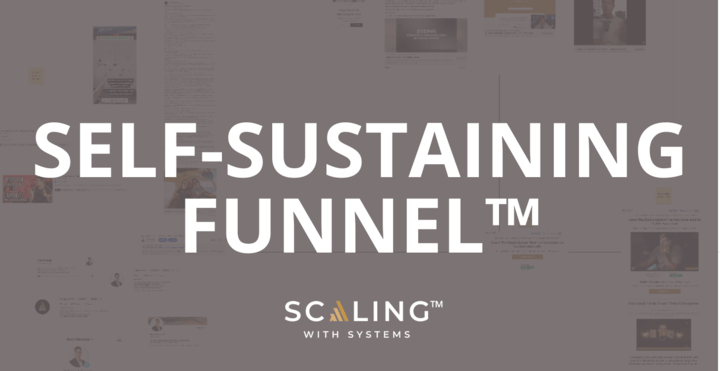Looking to maximize your return on investment (ROI) and increase profits with Facebook ads?
You need to learn how to set up the most profitable Facebook ad campaign structure to take your business to the next level.
Facebook is one of the best platforms for getting laser-targeted traffic that actually converts into customers
But if you don’t have a structured approach, getting results from your campaigns can be difficult.
That’s why having an effective strategy is essential for success when running ads on Facebook.
In this article, we’ll talk about the best way to set up a Facebook ad campaign. You’ll get tips on how to set up campaigns that bring in sales and leads without breaking your budget.
Facebook Ad Campaign Structure: An Overview
You need careful planning and preparation to create a successful Facebook ad campaign structure.
Here’s a quick overview of what you’ll need to have in place for your Facebook ad campaign:
- An objective
- An audience
- Ad Content
- Ad placement
- Budget and timeline.
With Facebook expected to make $75.11 billion from ads by 2024, now is the time to finalize your Facebook ad campaign structure.
What Are Campaign Ads for Facebook?
A Facebook ad campaign is an online advertising strategy that uses targeted messages to reach a specific audience on the popular social media platform.
The goal is to encourage your target audience to take action. That action directly correlates to your overall goal – more profit. Most campaign goals relate to conversion actions like signing up for a webinar, downloading the lead magnet to get on a mailing list, or a direct sale.
Benefits Of A Perfect Facebook Ad Campaign Structure
A well-structured Facebook ad campaign allows you to get better performance from your ads, saving you time and money in the process.
Here are a few more benefits of a well-structured Facebook ad campaign:
- Proper targeting of the right audience: Target your ads toward the most relevant and interested individuals who are more likely to become customers.
- Improved click-through rate: With an effective structure, your ads will have a higher click-through rate, as users will be more likely to click on them when they see something relevant.
- Ability to track results: Easily track ad performance and optimize based on collected data like clicks and impressions.
- Increased engagement: A good structure improves users’ engagement with the ads, resulting in higher conversions and sales.
- Better Return On Investment (ROI): The improved performance of your campaigns ensures a better ROI.
Important Aspects Of Managing Facebook Ads
It can be tricky to organize and manage Facebook ads. Keep the following strategies in mind to get better results with your campaigns:
Naming Conventions
Use a consistent naming convention for your Facebook ad campaigns. For example, use the same name for each ad and the corresponding campaign. This ensures that you can easily keep track of all the different aspects of your ads and campaigns. If you’re split-testing (contrasting two different ads’ performances to define the best ad structure, then be sure to name them as V1 and V2, or A and B – something that’ll help you track the split test.
Define The Campaign Level
The campaign level dictates your advertisement campaigns’ look, feel, and success. This includes who it targets, how much return on ad spend (ROAS) you can expect, and how your objectives will be met.
When constructing a campaign, consider what business goal you are trying to achieve. Is it awareness, traffic, engagement, leads, or app promotion?
With a clear goal in mind, align your creative content to your brand identity and message to guide people toward engaging with your brand.
For example, if your objective is to increase page visits or sign-ups for an eCommerce website, then set this as the campaign’s primary goal so Facebook Ads Manager can push it out to the right audience.
Specify where visitors should go after clicking on the ad; this could be the homepage or another dedicated landing page.
As well as having single campaigns at your disposal, you also have multiple campaigns which offer further options for reaching different objectives.
Remember to set appropriate bid amounts and bidding strategies to ensure effective results.
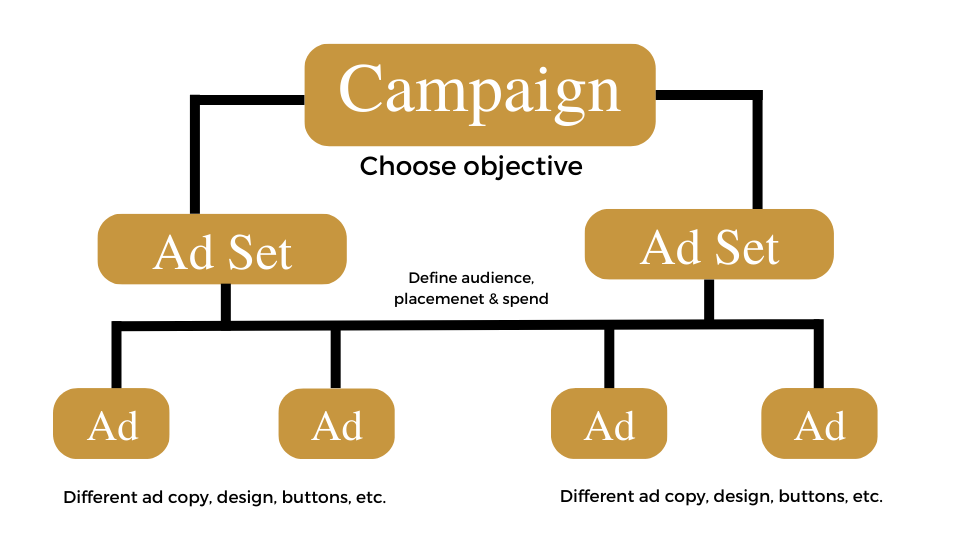
Ads Set Sub-level
At the ad set sub-level, you’ll choose your audience and define how they will be targeted. Segment your ad sets according to the following audiences:
- Core Audiences: Users who make up the pool of people you target based on their age, interests, and other demographic data that define them.
- Lookalike Audiences: Automatically generated audiences whose profile is similar to that of the core audience you have identified.
- Custom Audiences: You set up specific audiences based on data obtained from the core audience for more relevant marketing outreach.
If your campaign aims to increase sales, you could create multiple ad sets containing different products for different audiences. But remember, too much overlap between new and existing audiences may affect engagement. To avoid this issue, use the Audience Overlap tool when creating new ad sets.
Wondering how many ads sets per campaign is okay? As many as desired can be nested within a single ad campaign. Just double-check for high similarity levels between new and existing audiences.
Ads Creative Sub-level
This is where you choose the photo, video, CTA, GIF, and text for your ad’s content. With so many different formats for structuring your message, it can take time to decide which creative option best portrays your brand identity and message.
Use A/B testing to compare ad types and content variations to determine what works best.
The content used shouldn’t violate Facebook’s standards. Otherwise, engagement and conversion rates could potentially suffer as a result.
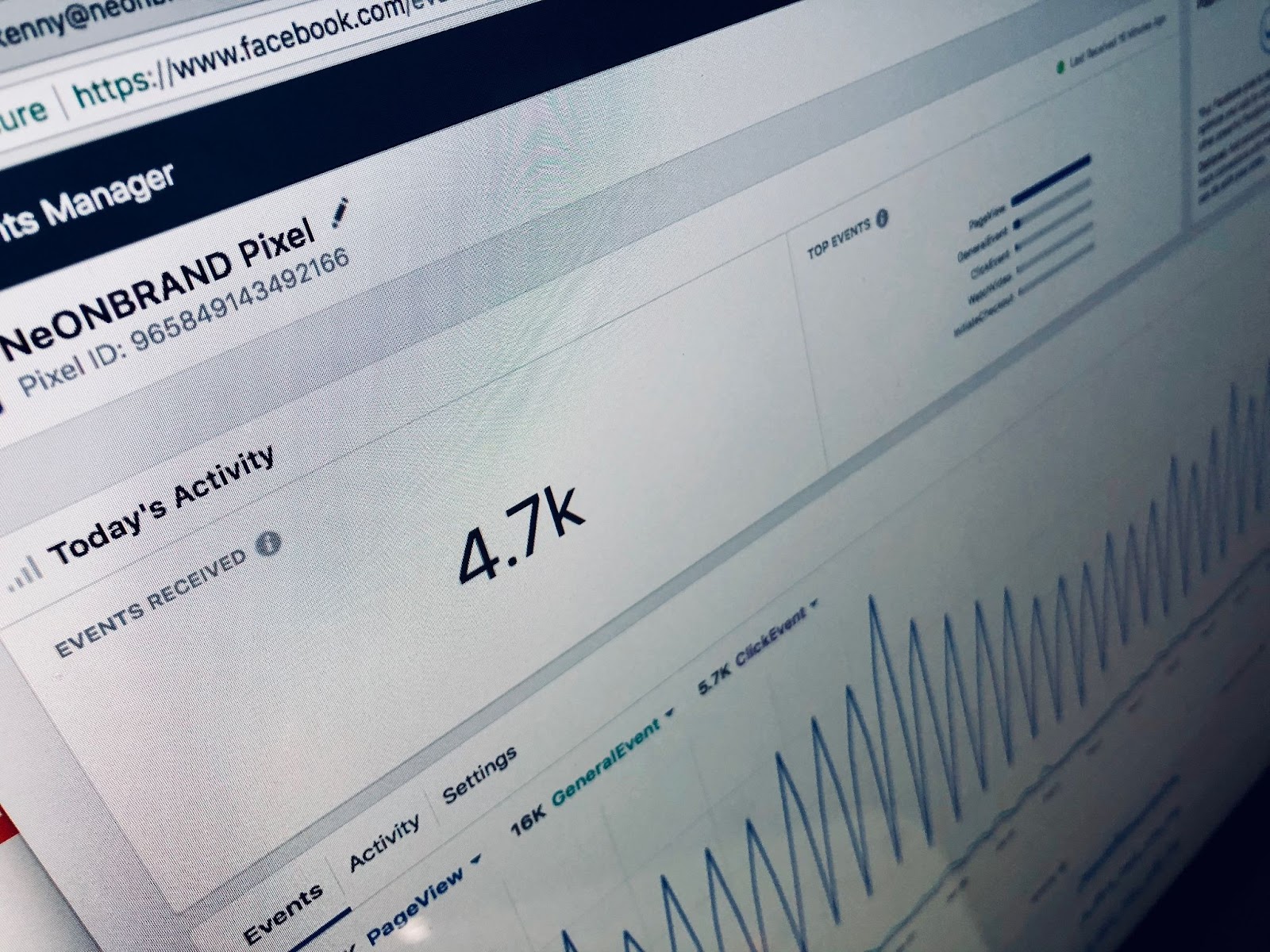
What’s The Perfect Facebook Ad Campaign Structure?
Careful consideration is required across several factors to create successful Facebook ad campaigns. These factors include the following:
1. Ad Campaign
Here’s a general outline for structuring a Facebook ad campaign:
- Define your objective
- Target audience
- Budget and Facebook ad strategy
- Placements
- Create ad sets
- Create ads
- Launch and monitor.
2. Ad Set
A Facebook ad set is a group of ads with their own budget, placement, bid settings, etc.
A single Facebook ad could be an image, a video, a carousel, or an instant experience.
When you put together more than one of the same ad, like multiple image ad creatives, you get an ad set. Then, you need to give each ad set that makes up the campaign a name that will help you keep track of it.
Misattributed Facebook Ads
Pay attention to the settings of each ad set to avoid misattributing Facebook ads. Misattributed ads are seen by people who weren’t part of the target audience or locations you had chosen for that particular ad set.
This can waste money, so keep an eye on how well each ad set performs. Read our blog on common Facebook ad mistakes to make sure your ads are never misattributed.
Setting/Launching Ad Sets
Once you’ve decided on your goal, target audience, and budget, made an ad set, and designed the ads that will go in it, your Facebook ad campaign is ready to go. Click the “Launch” button on the Ads Manager dashboard, and your campaign is live now.
Retargeting For Facebook Ad Campaigns
Target people who have already interacted with your brand in some way with retargeting ads.
This audience has previously engaged with your business by visiting your website or clicking on one of your ads.
Create retargeting ad sets tailored to these audiences to serve them relevant ads at the right time. This’ll ensure that the people who viewed your ads the first time get the highest chance of converting with that extra little ‘nudge’ with the retargeted ad. Sometimes people just need a reminder.
Choose Your Facebook Ad Campaign Structure By Campaign Type
Here are three ways you can structure your ad based on your chosen campaign.
Brand Awareness
If your ad campaign aims to get people to know about your brand’s products or services, focus on engagement optimization parameters.
Here’s an example: You want to get more people to visit your website.
- On the “Awareness” tab of the Ads Manager dashboard, choose “Brand Awareness” when setting the goals for a campaign.
- Under “Consideration,” choose “Traffic” or “Engagement.” And on the “Conversion” tab, choose the “Website” or “Store Visits” option.
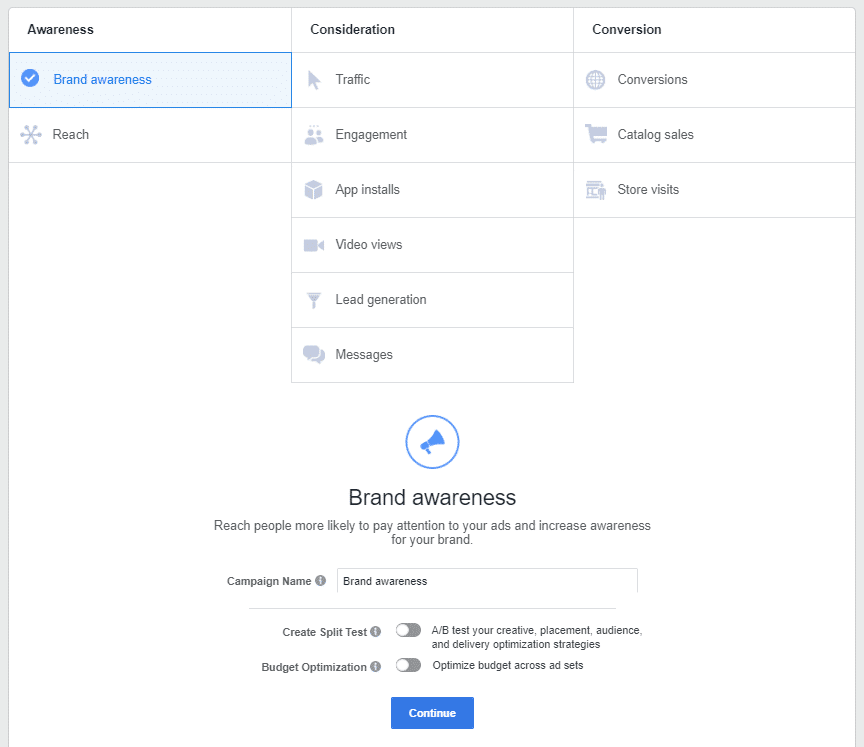
Prospecting
Prospecting involves looking for new audiences for the product in your ad. A prospecting campaign broadens your audience to “cold” potential customers.
The ad copy should contain enough information at the ad creative sub-level to get a new user interested in your brand.
- For prospecting ads, the campaign-level parameters and objectives need to stay the same as for brand awareness.
- You can select “Reach” instead of “Brand Awareness” as the awareness goal. And under the “Consideration” tab, you can select “Lead generation” instead of “Traffic”.
Marketing & Remarketing
Create your ad for marketing by setting the conversion goal at the campaign level to “Conversions” or “Catalog Sales.” Choose an ad creative that shows a unique reason for new users to buy, install, or subscribe to the product.
For remarketing, get in touch with people who already know your brand. Most of the time, they fit into one of these groups:
- People who have seen your content but haven’t bought anything yet
- Visitors to your landing page
- Buyers who left items in their shopping cart.
Best Practices For Ads Structuring
The following are our best practices for structuring your Facebook ads. There are many different ways you can do it, but in our experience at Scaling With Systems, these best practices give us (and our clients) a higher chance of success.
Keep Campaigns To A Minimum
Facebook permits you to build several campaigns for the same product. But remember, misusing this ability may lower conversions.
How? First, your audiences will overlap, affecting engagement and relevancy. As a result, you’ll waste money on several marketing campaigns with little or no returns.
Focus on one or two optimized ad campaigns instead of spamming Facebook. Locations can be used for brand awareness, prospecting, and retargeting.
Depending on your business objectives, test out different conversion events.
Leave The Bulk Of Optimization To The Algorithm
To boost their advertising, marketers routinely “game” the algorithm. It’s done; the result matters. These optimization techniques can ruin your ads.
Even though Facebook’s optimization algorithms are hard to understand, they give your ads the best chance to convert. Leave the algorithm to work its magic after setting your campaign goal for your ad creative.
Don’t Create New Campaigns And Ad Sets Every Time
Facebook examines your ad before optimizing it. Your engagement data determines your ad relevancy score.
It will optimize your ad to increase ROAS using this data. Optimizing your ad will take longer if you keep setting up new campaigns.
Successful ad campaigns should run for a long time to help Facebook learn about them. Make changes based on the data without ending the campaign. Soon, your ad will meet conversion and engagement goals.
Improve The Ad Creative
Ad creativity must meet quality requirements and engage your target demographic. Remember that you’re fighting for short-attention-span users.
Make your ad stand out with these tips:
- Ad copy should be brief
- Inspire users with meaningful CTAs
- Use high-quality photos and videos
- Custom images atop stock photos
- Use color to convey an emotion
- Ad design should be device-optimized
- Employ automation to track ad success metrics to determine the ideal Facebook marketing strategy.
Examples Of Perfect Facebook Ad Campaigns
Here are two examples of high-performing Facebook ads from some killer companies.
Example 1
Monday.com manages tasks on desktop and mobile platforms. In the picture ad below, the company used the fact that its software works on Macs to make its logo look like Apple’s rainbow colors.
Monday.com does great at leveraging familiar brands to target specific audiences. The ad targets Mac users by filling the Monday logo with Apple’s rainbow color scheme.
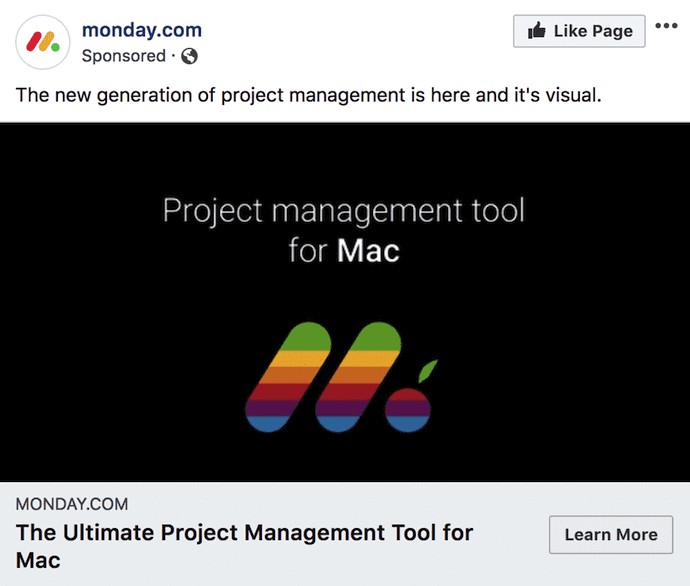
Why it’s successful:
- Visual: Mac users will recognize Monday’s rainbow logo on a dark background.
- Relevant: Mac users and task organizers will relate to this commercial.
- Value: The ad highlights Monday’s Mac compatibility, making it more appealing to Mac users.
- CTA: The bottom-right “Learn More” CTA invites viewers to learn more about this product’s use on Apple hardware.
Example 2
The New York Times photo commercial promotes an article with captivating artwork. Working parents are depicted in the drawing. This image and the statistically supported story in the title show a fatigued woman trying to rest with her children.
If their main product is a good reading experience, publishers who want to advertise on Facebook should use featured photos that make people feel something. The emotional imagery is a great hook.
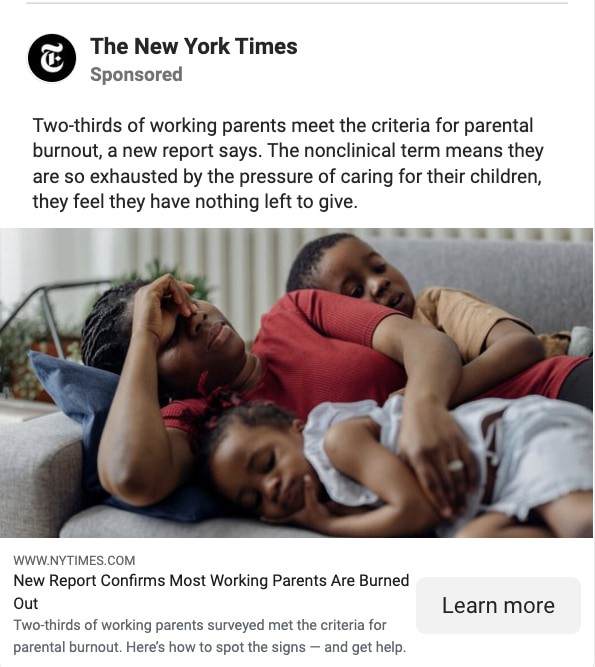
Why it’s successful:
- Visual: This ad is emotionally powerful since you’ve probably encountered exhausted, working parents, which can make you feel compassion for them.
- Relevant: In the wake of COVID-19, parents juggling work and family is relatable.
- Value proposition: Social proof increases article clicks and reads.
- CTA: This ad encourages parents to “Learn More” to get answers and understand the indications of weariness.
Four Tips For Creating An Unbeatable Campaign
Here are our top four tips for making the best Facebook campaign structure that can’t be beaten.
1) Create An Unbeatable Offer
Create an unbeatable offer to ensure a profitable Facebook ad campaign. With an offer that can’t be beaten, stand out from the crowd and get more people interested in your business. Offers too good to pass up will help you convert more leads, gain more followers, and boost sales.
2) Track Sales
To ensure a profitable Facebook ad campaign, tracking sales is vital. Track sales to gain valuable insights into the performance of your advertising campaigns and what strategies are working best for you.
Also, it shows businesses how customers act, what they like, and how well their advertising campaigns work.
That way, businesses can determine which ads lead to the most sales and conversions.
3) Build Ads, Not Create
Build ads instead of creating them to have a successful and profitable Facebook ad campaign. Your ad should be engaging and compelling to attract potential customers.
Building an ad takes more effort than just creating one, but the payoff can be far greater if done correctly.
4) Set Clear Goals
Clear goals are essential to create Facebook ad campaigns that work. Set clear goals to focus your efforts on what matters most. As a result, you’ll be able to measure the effectiveness of their campaigns.
Marketers can also figure out what worked and didn’t to improve their campaigns. If your Facebook ads still aren’t converting, read our blog on how to fix them.
Facebook Ad Campaign: FAQs
Which ad format is best for Facebook?
It depends on the objective and target audience of your advertising campaign. Some popular and effective Facebook advertising structure formats include:
- Image and Video Ads: Showcase products, services, or brand awareness.
- Carousel Ads: Showcase multiple products or services within a single ad.
- Slideshow Ads: Similar to carousel ads but focused on motion and animation.
- Collection Ads: A full-screen immersive ad format that lets users browse products before leaving Facebook.
- Story Ads: Vertical full-screen ads that appear in Facebook and Instagram Stories.
How to structure Facebook ad campaigns?
For the structure of Facebook ad campaigns, you should follow these steps:
- Define your objective
- Target your audience
- Choose your ad format
- Create compelling ad content
- Set your budget and bid
- Launch your ad campaign
- Analyze and optimize.
Remember to follow the Facebook advertising structure rules to ensure your ads align with them.
What are the four Facebook advertising best practices?
Here are four best practices for Facebook advertising:
- Clearly define your objectives: Before launching an ad campaign, you must determine your goal. This will help you make informed targeting, ad format, and budget decisions.
- Target your audience accurately: Understand your target audience to reach the right people and improve your chances of success. Use Facebook’s targeting options to narrow your audience based on demographics, interests, and behaviors.
- Make your ad content enjoyable: Use high-quality visuals and clear, concise language to grab your audience’s attention and communicate your message effectively.
- Always test and improve: Keep an eye on how well your ad is doing and make changes as needed to get better results. Test different ad formats, images, copy, and targeting options to find what works best for your business.
Profitable Facebook Ad Strategy: Conclusion
Ad campaigns on Facebook are an excellent way to reach your target audience and boost sales. Use the tips in this article to plan your campaign and create the best Facebook ad structure.
Remember to follow Facebook’s advertising rules and policies to ensure that your ads comply with their guidelines. With these strategies in place, you can launch a successful Facebook ad campaign and reach your goals.
Unlock the limitless potential of your business with our expert support!
Put your mind at ease and take advantage of our tried-and-tested client acquisition strategies that help you streamline operations, attract quality leads, and give you back your time.
Imagine a brighter future for your business where growth comes naturally, leaving you immensely satisfied. Book a free consultation call with us today to learn more.


